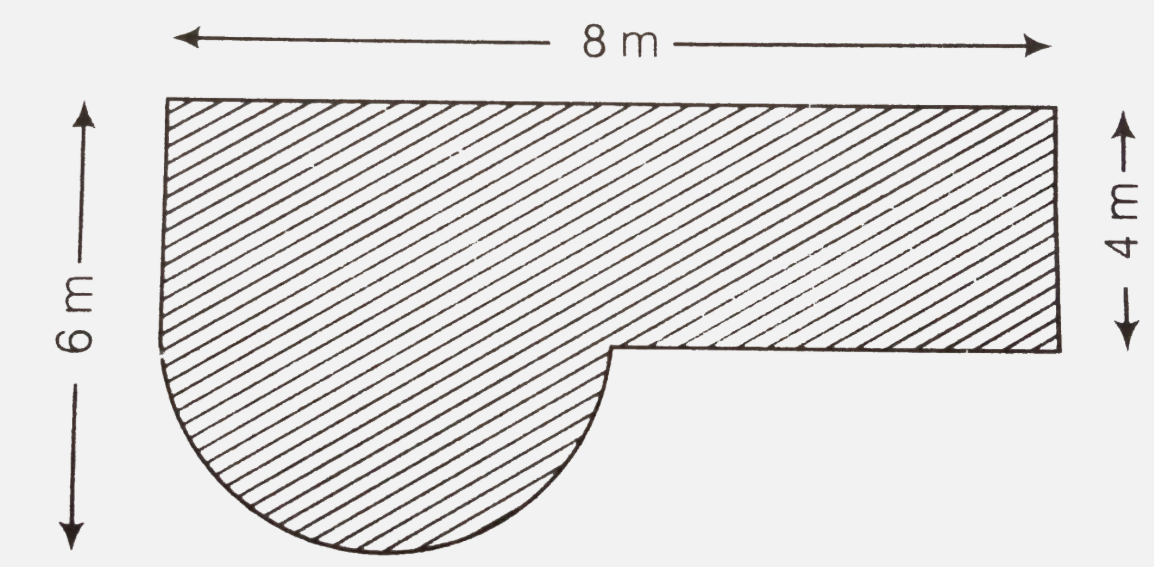There is a pentagonal shaped park as shown in the figure. For finding its area Jyoti and Kavita divided it in two different ways. Find the area of this park using both ways. Can you suggest some other way of finding its area?
To find the area of the pentagonal shaped park using both Jyoti's and Kavita's methods, follow these steps:
Method 1: Jyoti's Method (Dividing into Two Trapeziums)
1. Identify the Trapeziums: Jyoti divides the pentagon into two trapeziums. Let's denote the trapeziums as Trapezium 1 and Trapezium 2.
2. Determine the Dimensions:
- The height (h) between the two trapeziums is given as 15 meters.
- The lengths of the parallel sides of the trapeziums are 30 meters and 15 meters.
3. Use the Area Formula for Trapezium:
The area A of a trapezium can be calculated using the formula:
A=12×h×(a+b)
where a and b are the lengths of the parallel sides.
4. Calculate the Area of One Trapezium:
For one trapezium:
A=12×15×(30+15)=12×15×45=6752=337.5 m2
5. Total Area of the Pentagon:
Since there are two identical trapeziums:
Total Area=2×337.5=675 m2
Method 2: Kavita's Method (Dividing into a Triangle and a Square)
1. Identify the Shapes: Kavita divides the pentagon into a triangle and a square.
2. Determine the Dimensions:
- The height of the triangle is 15 meters, and the base is also 15 meters.
- The side of the square is 15 meters.
3. Calculate the Area of the Triangle:
The area A of a triangle can be calculated using the formula:
A=12×base×height
So,
A=12×15×15=2252=112.5 m2
4. Calculate the Area of the Square:
The area A of a square can be calculated using the formula:
A=side×side
So,
A=15×15=225 m2
5. Total Area of the Pentagon:
Combine the areas of the triangle and the square:
Total Area=112.5+225=337.5 m2
Conclusion
Both methods yield the same area for the pentagonal park, which is 337.5 m².
- The height (h) between the two trapeziums is given as 15 meters.
- The lengths of the parallel sides of the trapeziums are 30 meters and 15 meters.
The area A of a trapezium can be calculated using the formula:
A=12×h×(a+b)
where a and b are the lengths of the parallel sides.
For one trapezium:
A=12×15×(30+15)=12×15×45=6752=337.5 m2
Since there are two identical trapeziums:
Total Area=2×337.5=675 m2
- The height of the triangle is 15 meters, and the base is also 15 meters.
- The side of the square is 15 meters.
The area A of a triangle can be calculated using the formula:
A=12×base×height
So,
A=12×15×15=2252=112.5 m2
The area A of a square can be calculated using the formula:
A=side×side
So,
A=15×15=225 m2
Combine the areas of the triangle and the square:
Total Area=112.5+225=337.5 m2
Both methods yield the same area for the pentagonal park, which is 337.5 m².
Topper's Solved these Questions
- LINEAR EQUATION IN ONE VARIABLEBOOK - RD SHARMA ENGLISHCHAPTER - LINEAR EQUATION IN ONE VARIABLEEXERCISE - All Questions
110 Videos
- MENSURATION-II (VOLUMES AND SURFACE AREAS OF A CUBOID AND A CUBE)BOOK - RD SHARMA ENGLISHCHAPTER - MENSURATION-II (VOLUMES AND SURFACE AREAS OF A CUBOID AND A CUBE)EXERCISE - All Questions
134 Videos
Similar Questions
There is a regular hexagon MNOPQR of side 5 cm . aman and ridhima divided it into two different ways . Find the area of this hexagon both ways.
View SolutionThere is a regular hexagon MNOPQR of side 5 cm . aman and ridhima divided it into two different ways . Find the area of this hexagon both ways.
View SolutionFind the area of the pentagonal park shown in Figure in two different ways:
View SolutionFind the area of a circular park with diameter 70 m.
View SolutionUsing the information in the following figure, find its area.

View SolutionFind the area of the shape shown in the figure 10.10.
View SolutionFind the area of a circular park whose radius is 4.5 m
View SolutionFind the area of the shaded field shown in figure.

View SolutionFind the area of a square park whose perimeter is 320 m.
View SolutionFind the area of a square park whose perimeter is 320 m.
View Solution
